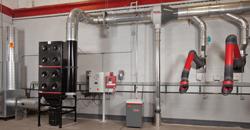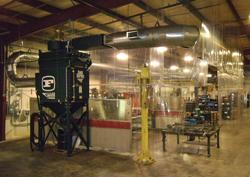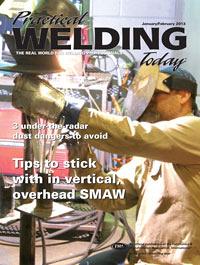- FMA
- The Fabricator
- FABTECH
- Canadian Metalworking
Categories
- Additive Manufacturing
- Aluminum Welding
- Arc Welding
- Assembly and Joining
- Automation and Robotics
- Bending and Forming
- Consumables
- Cutting and Weld Prep
- Electric Vehicles
- En Español
- Finishing
- Hydroforming
- Laser Cutting
- Laser Welding
- Machining
- Manufacturing Software
- Materials Handling
- Metals/Materials
- Oxyfuel Cutting
- Plasma Cutting
- Power Tools
- Punching and Other Holemaking
- Roll Forming
- Safety
- Sawing
- Shearing
- Shop Management
- Testing and Measuring
- Tube and Pipe Fabrication
- Tube and Pipe Production
- Waterjet Cutting
Industry Directory
Webcasts
Podcasts
FAB 40
Advertise
Subscribe
Account Login
Search
Three under-the-radar dangers in weld shops
Pay attention to fume and dust collection to stay safe
- By Amanda Carlson
- January 16, 2013
- Article
- Safety
Creating a safe work environment doesn’t stop with just cleaning the air; it also involves continually assessing the types of dust and fume you are generating and how your fume collection system works to ensure the necessary prevention equipment is in place to prevent fires.
Today’s job shops perform a variety of metal fabricating processes under one roof. Whether it’s cutting, grinding, stamping, or welding, each of those processes generates fumes or metal dusts. Those dust particles, depending on their makeup, can be hazardous. Most of us are very familiar with the hazards of breathing in toxic fumes, but here are three not-so-obvious reasons that you need to pay close attention to your dust collection practices.
No. 1: Metallic Dust Accumulation
Fume extraction is an essential part of creating a safe work environment in a welding and fabricating setting, this much is obvious. One of the most important reasons to employ good fume extraction practice, especially for those working with stainless steel or coated materials, is to lower the risk of welders breathing toxic fumes and weld particulate, especially if the fume and particulate generated contains hexavalent chromium.
But what you may not realize is the injury risk factors that cutting or grinding dust has on a shop environment. For starters, it’s a nuisance, said Greg Schreier, metalworking market manager at Camfil Farr APC, Jonesboro, Ark. When metallic dust accumulates on surfaces, from desktops and computer screens to papers and other office supplies, it creates a cumbersome and unpleasant work environment.
It’s also a skin and eye irritant.
“People experience eye irritation. They have red, scratchy, or dry eyes or experience problems with contact lenses. And for people with glasses with plastic lenses, the static electricity causes these particles to stick to them, which is a hassle and a potential safety issue,” Schreier added.
Significant dust accumulation can wreak havoc on CNC-operated electrical equipment too. CNCs are typically cooled by a small fan with plastic blades. When dust particles adhere to and accumulate on those plastic blades, they become heavy or imbalanced, which could cause the fan to fail and the machine to shut down, leading to unnecessary downtime.
“A maintenance man has to find the fan and clean it or he’s forced to put small filters in front of the fan to filter the air. But the fan isn’t designed to pull air through a filter, so airflow is reduced, the cooling function of the fan is reduced, and the problem just continues to multiply,” Schreier explained.
Dust accumulation on floors and steps creates a slip and fall hazard as well.
“Every shop is different, and every dust is different, but the human and shop floor exposures cause a lot of problems, many of which can be eliminated by proper air filtration using a high-efficiency cartridge dust and fume collector.”

Spark arrestors in your dust and fume collection system provide an added layer of protection against fire risks.
No. 2: Combustible Dust
According to an article published in the August 2009 issue of CEP Magazine, the following criteria must be met simultaneously to produce a dust explosion:
- The dust must be combustible.
- The dust must be airborne.
- The dust must be present in a concentration that is within explosible range.
- Particle size distribution must be capable of propagating a flame.
- The atmosphere of the dust cloud must be able to support combustion.
- An ignition source with enough energy to initiate flame propagation must be present.
It’s not difficult for these criteria to be met in a welding and fabricating environment, especially one that processes multiple materials. If you aren’t careful and diligent about collecting metal dust, you may be at risk for an explosion, said Pat Gilmour, business development representative at RoboVent, Clawson, Mich.
Gilmour noted mixing ferrous with nonferrous particles, like steel and aluminum, as a risk factor. There’s no threat if two large pieces of steel and aluminum are sitting next to one another. It’s the small particles that pose the hazard.
“There’s no actual particle size limit, but the smaller the particle, the more evenly it can disperse through an air space,” Gilmour said.
Shops performing laser cutting using an inert shielding gas like nitrogen or argon, for example, release dust particles with active carbons that have not been consumed because the inert gas does not support combustion. What you end up with are minute particles that actually have an enormous amount of carbon or potential energy within them. When that energy consumes itself, there’s the potential for explosions, Gilmour added. If those particles encounter an ignition source, such as hot work like welding or cutting or a static discharge, trouble can follow.
Proper dust collection practices can help remove dusts from the environment. Even so, Gilmour suggests that if you are collecting multiple types of dusts into one collection unit, be sure to position it outside your facility and fit it with an explosion vent. On a related note, make sure the dust collector and explosion vent are not positioned in an area outdoors that could pose a danger to passersby.
“I was at a facility that positioned its dust collector outside; however, they had a smoking area for their employees and it was about 15 ft. away from the explosion vent of the dust collector.”
Last, investigate using a wet dust collector for collecting steel and aluminum dust.
No. 3: Dust Collector Fire Hazards
Chris Brodnick, business manager for safety and environmental products at Lincoln Electric, Cleveland, said it’s not a matter of if you’ll have a dust collector fire, it’s when.
“It’s something that we’ve seen. There have been some customers that I’ve talked to where it’s happened so frequently that they’ll call it a ‘thermal event.’ I guess they don’t want the word fire recorded,” Brodnick said.
Shops that perform cutting and stamping in their facilities typically take parts that have been treated with cutting oil or press oil directly to their welding area. Granted, some of the oil burns off during the welding process, but the oil that does not burn off adheres itself to welding particulate. When that oily and sticky type of welding particulate enters the extraction system, it introduces oil to your filter banks, Brodnick explained.
“You have a filter bank that houses all of the filters, which are either paper or a cellulous-type material. You have oil that you’ve introduced with your fume particulate, and you have plenty of air that you’re pulling through. You have paper, oil, and air. Now all you need is a spark for there to be a potential fire risk. When you evaluate welding, cutting, and grinding, sparks are common.”
Adding a spark arrester to your dust and fume collection system will help snuff out fires before they spin out of control. Spark arresters corral the spark away from flammable materials within the dust collector, provide an environment where it loses inertia, and dispose of it—in some cases in an external dust bin. Once a spark is extinguished, it no longer poses the risk of reigniting.
Brodnick emphasized how quickly a fire inside a dust collector can spin out of control. Employing means to prevent that from occurring not only saves your dust collector from significant damage, it saves your shop from catastrophic damages and, most important, adds an extra layer of protection for workers.
“If you can avoid that, you’re ahead of the game and you’ve created a much safer work environment for your employees,” Brodnick said.
About the Author

Amanda Carlson
2135 Point Blvd
Elgin, IL 60123
815-227-8260
Amanda Carlson was named as the editor for The WELDER in January 2017. She is responsible for coordinating and writing or editing all of the magazine’s editorial content. Before joining The WELDER, Amanda was a news editor for two years, coordinating and editing all product and industry news items for several publications and thefabricator.com.
About the Publication
subscribe now

The Welder, formerly known as Practical Welding Today, is a showcase of the real people who make the products we use and work with every day. This magazine has served the welding community in North America well for more than 20 years.
start your free subscription- Stay connected from anywhere

Easily access valuable industry resources now with full access to the digital edition of The Fabricator.

Easily access valuable industry resources now with full access to the digital edition of The Welder.

Easily access valuable industry resources now with full access to the digital edition of The Tube and Pipe Journal.
- Podcasting
- Podcast:
- The Fabricator Podcast
- Published:
- 04/16/2024
- Running Time:
- 63:29
In this episode of The Fabricator Podcast, Caleb Chamberlain, co-founder and CEO of OSH Cut, discusses his company’s...
- Trending Articles
Sheffield Forgemasters makes global leap in welding technology

Welding student from Utah to represent the U.S. at WorldSkills 2024

Lincoln Electric announces executive appointments

Lincoln Electric acquires RedViking

Engine-driven welding machines include integrated air compressors

- Industry Events
16th Annual Safety Conference
- April 30 - May 1, 2024
- Elgin,
Pipe and Tube Conference
- May 21 - 22, 2024
- Omaha, NE
World-Class Roll Forming Workshop
- June 5 - 6, 2024
- Louisville, KY
Advanced Laser Application Workshop
- June 25 - 27, 2024
- Novi, MI



























